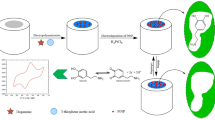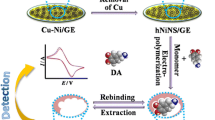Abstract
Ion selective electrodes (ISE) for organic ions are in principle suitable for rapid in situ determinations. A critical point in the development of ISEs is to find out specific receptors. In this investigation the possibility of developing solid state ISEs with molecularly imprinted acrylic polymers (MIP) as a recognition element was investigated. As a proof case, an all-solid-state ISE for dopamine (DAH+) was prepared. In order to attain a real miniaturization of the whole measuring device, the reference electrode too was an all-solid-state one, based on the same polymer used for the working electrode but in the absence of template. A screen printed graphite electrode modified with multiwalled carbon nanotubes as an ion to electron transducing layer was used as conducting substrate. The cell potential linearly increases at dopamine concentration higher than 10−4 M, but the sensibility is less than nernstian (16 mV/dec). The sensor is very selective for the template.
Access provided by Autonomous University of Puebla. Download conference paper PDF
Similar content being viewed by others
Keywords
- Modify Electrode
- Molecular Imprint Polymer
- Multiwalled Carbon Nanotubes
- Potentiometric Sensor
- Filling Solution
These keywords were added by machine and not by the authors. This process is experimental and the keywords may be updated as the learning algorithm improves.
Introduction
Potentiometry is in principle a convenient transduction method for sensors, even compared with other electrochemical techniques [1, 2], because of the short response time, the absence of net electrodic reactions, the limited dimension of the apparatus, and the robustness and low cost of instrumentation.
Many potentiometric sensors for negatively and positively charged inorganic ions have been developed (ISE: ion selective electrodes), based on membranes containing ionophores which impart selectivity to the device. Despite of their high practical interst, much less investigations have been devoted to the development of ISE for organic ions, probably because the synthesis of specific receptors for organic ions [3] is a quite demanding task. A relatively easy way to produce selective synthetical receptors is by molecular imprinting techniques. For example an anion exchanging conducting polymer obtained by electropolymerization in the presence of the analyte has been proposed in a recent paper [4]. It was used for a potentiometric sensor for l-ascorbic acid. The possibility of applying molecularly imprinted acrylic polymers (MIP) as selective membranes for potentiometric sensors has been investigated, too. Most often, small MIP particles are dispersed in plastic matrices, so acting as the more usual molecular ionophores in ISE [5, 6]. A different approach can be the use of a monolithic MIP membrane implemented in a symmetrical potentiometric device with inner filling solution. One of the first devices of this kind was proposed a few years ago by our research group [7]. More recently the possibility of developing an all-solid-contact ISE, avoiding the inner filling solution, was investigated with the aim of obtaining a smaller and more robust potentiometric sensor [8]. The monolithic MIP membrane was obtained by in situ polymerization on a conducting support constituted by a screen printed graphite electrode covered with a thick layer of multiwalled carbon nanotubes (MWCNT). This was interposed between the carbon ink surface and polymer to assure an effective ion-to-electron transduction [2, 9]. In the present investigation the possibility of developing an all-solid-state reference electrode suitable for potentiometric determinations based on MIP has been considered, with the aim of obtaining a true miniaturisation of the potentiometric device. Actually reliable solid-state reference electrodes are highly required to substitute the bulky Ag/AgCl reference electrodes [10].
Experimental
Chemicals and materials were as previously reported, as was the preparation of the molecular imprinted polymer (MIPE) and not-molecular imprinted polymer (NIPE) modified electrodes [8]. The only difference was that ethanol instead of DMF was used as solvent in order to avoid damages to the insulating layer of the screen printed electrodes. MIP and NIP monoliths were prepared by copolymerization of methacrylic acid (MAA) and ethylene glycol-dimethacrylate (EGDMA) in the presence of AIBN as radicalic initiator, at 70 °C. The working electrode was made of graphite ink coated with multiwalled carbon nanotubes. The new reference electrode tested in the present investigation was a NIP modified electrode (NIPE) obtained by drop coating an Ag screen printed electrode with the prepolymeric mixture not containing the template, and by in situ polymerization.
Results
Some examples of potential variation at different salt concentration of MIP-modified electrodes (MIPE) and NIP-modified electrodes (NIPE) are reported in Fig. 24.1. For comparison some results obtained at multiwalled carbon nanotubes modified electrode (CNTE) not coated with polymer are shown, too. The salt concentration slightly affects the measured potential, particularly at concentration higher than about 10−4 M, while the salt nature has a stronger influence, not only in the case of MIPE and NIPE, but also of CNTE. At the same salt concentration, the higher potential is in KF, and then KNO3 and KCl solution (pH = 5.5), while the potential is lower in phosphate solution (pH = 7). This can be related either to the different interaction of the anions with the conducting substrate, or to the effect of the solution pH on the ionic composition of the ion exchange polymer, MIP or NIP, and of the conducting surface. The deprotonation degree, and consequently the concentration of the fixed anionic groups in the polymer phase, and the concentration of deprotonated sites at the CNT surface, increases with pH, so producing a lower potential at the interfaces.
At the same salt concentration the potential is always higher in NIPE than in MIPE, but the potential difference between MIPE and NIPE is constant at concentration higher than 10−4 M, being 55 mV both in KNO3 and KH2PO4 solution.
The calibration curve for DAH+ in 0.1 M KCl at MIP modified electrode, and with reference electrode Ag/AgCl/KCl(sat.) is:
On the contrary there is not any response to dopamine in the case of NIPE. For these reasons it is believed that the screen printed electrode modified with NIP with the same composition of the corresponding MIP can be used as reference electrode in potentiometric measurements.
The calibration curve of dopamine in 0.1 M KCl, obtained in the potentiometric device using NIPE as reference electrode is:
The ordinate at the origin is near to the difference of MIPE and NIPE potentials reported in Fig. 24.1. The slope is not nernstian and is lower than that obtained with a MIPE synthesized using DMF instead of ethanol in the polymeric mixture. This point could probably be improved by changing the solvent of the polymeric mixture.
In both cases the non nernstian slope can be explained on the basis of the interface potential model [1].
Other cations as epinephrine, tyramine and nicotine, similar to DA for charge and structure, do not produce any potential variation in function of the concentration. This shows the very good selectivity of imprinted sites the membrane.
Conclusions
An all-solid-state potentiometric sensor for dopamine has been developed, based on a specific MIP at the working electrode (graphite electrode modified with CNT) and on the same polymer but polymerized in the absence of the template (NIP) at the reference electrode (Ag ink electrode). It has been found that the potential increases at increasing concentration of dopamine, with a lower than nernstian slope, and that the detection limit was relatively high. However the device is promising for potentiometric detection particularly because of its high selectivity and the low dimension. Optimization of the condition for sensor preparation is now under study.
References
Bobacka J, Ivaska A, Lewenstam A (2008) Potentiometric ion sensors. Chem Rev 108:329–351
Yanez-Sedeno P, Riu J, Pingarron JM, Rius FX (2010) Electrochemical sensing based on carbon nanotubes. Trends Anal Chem 29:939–953
Ampuradanes J, Crespo GA, Maroto A, Angeles Sarmentero M, Ballester P, Rius FX (2009) Determination of choline and derivatives with a solid-contact ion-selective electrode based on octaamide cavitand and carbon nanotubes. Biosens Bioelectron 25:244–349
Tonelli D, Ballarin B, Guadagnini L, Mignani A, Scaletta E (2011) A novel potentiometric sensor for l-ascorbic acid based on molecularly imprinted polypyrrole. Electrochim Acta 56:7149–7154
Liang RN, Zhang R, Qin MW (2009) Potentiometric sensor based on molecularly imprinted polymer for determination of melamine in milk. Sens Actuators B 141:544–550
Oliveira HMV, Moreira FTC, Sales MGF (2011) Ciprofloxacin-imprinted polymeric receptors as ionophores for potentiometric transduction. Electrochim Acta 56:2017–2023
D’Agostino G, Alberti G, Biesuz R, Pesavento M (2006) Potentiometric sensor for atrazine based on a molecular imprinted membrane. Biosens Bioelectron 22:145–152
Pesavento M, D’Agostino G, Biesuz R, Alberti G, Profumo A (2012) All-solid-state ion selective electrode for dopamine based on a molecularly imprinted polymer. Electroanalysis 24:813–824
Crespo GA, Macho S, Rius FX (2008) Ion-selective electrodes using carbon nanotubes as ion-to-electron transducers. Anal Chem 80:1316–1322
Rius-Ruiz FX, Kisiel A, Michalska A, Maksymiuk K, Riu J, Rius FX (2011) Solid-state reference electrodes based on carbon nanotubes and polyacrylate membranes. Anal Bioanal Chem 399:3613–3622
Author information
Authors and Affiliations
Corresponding author
Editor information
Editors and Affiliations
Rights and permissions
Copyright information
© 2014 Springer Science+Business Media New York
About this paper
Cite this paper
Pesavento, M., D’Agostino, G., Profumo, A., Biesuz, R., Alberti, G. (2014). Potentiometric Sensors Based on Molecular Imprinted Polymers. In: Baldini, F., et al. Sensors. Lecture Notes in Electrical Engineering, vol 162. Springer, New York, NY. https://doi.org/10.1007/978-1-4614-3860-1_24
Download citation
DOI: https://doi.org/10.1007/978-1-4614-3860-1_24
Published:
Publisher Name: Springer, New York, NY
Print ISBN: 978-1-4614-3859-5
Online ISBN: 978-1-4614-3860-1
eBook Packages: EngineeringEngineering (R0)





